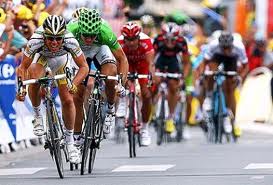 Being a sprinter by nature, explosive efforts are one of my favorite topics. It is not too surprising however that this was one of the elements of indoor cycling that made me sit up and think “huh?”. Besides the bad form, lack of any recovery and unrealistic lengths (i.e. 2 minutes), people seemed to fall to one cadence extreme or the other when the instructor yelled “sprint”. Some riders overloaded their bikes with so much resistance that it look as if they were wrestling an alligator to the ground trying to turn the pedals. Others had their legs spinning so fast that their bodies morphed into crazed jackhammers.
Being a sprinter by nature, explosive efforts are one of my favorite topics. It is not too surprising however that this was one of the elements of indoor cycling that made me sit up and think “huh?”. Besides the bad form, lack of any recovery and unrealistic lengths (i.e. 2 minutes), people seemed to fall to one cadence extreme or the other when the instructor yelled “sprint”. Some riders overloaded their bikes with so much resistance that it look as if they were wrestling an alligator to the ground trying to turn the pedals. Others had their legs spinning so fast that their bodies morphed into crazed jackhammers.
Putting the technical and tactical aspects of sprinting aside, sprints are a combination of fast leg speeds and maximal force. To get an idea of leg speed, let”™s look at some of my favorite professional sprinters and see how fast they are turning their legs as they charge for the finish line:
Mark Cavendish: 110 — 125 RPM
Tom Boonen: 115 — 118 RPM
Thor Hushovd: 98 — 110 RPM
Erik Zabel: 108 — 118 RPM
Mario Cipollini: 105 — 118 RPM
Now keep in mind that these guys are generating upwards of 1200watts (Cavendish has been said to average ~1600watts). Needless to say, they would have a good amount of resistance on their indoor bikes if they were sprinting in one of our classes. So how do we teach our riders to use a realistic amount of resistance and legs speed? Before I give you a game you can play, remember that sprints (in the cycling world) are maximum efforts. We have a saying “if you”™re not going to sprint at 110%, don”™t bother”. So that being said, we need to: (1) make sure everyone is using good form so they don”™t get injured, (2) have ample time to recover so then can give 110% again and (3) are not asked to sprint longer than 30 seconds (which is a LONG time at “all you”™ve got”). Make sure you urge riders to work at their own pace and simply only work on sprinting form if they are not able to push the higher intensities.
How much power can you generate at ______ RPM?
Here is a little game that can be made into a class (providing you have power and cadence displayed on your bike). Have riders hold an 80 RPM cadence and then add as much resistance as they can and sprint without slowing down their legs. This can be done seated or standing. Perform 3 to 4 sprints at 80 RPM (with 2 minutes of recover between efforts) and see if riders can start to figure out which resistance (or gear) combination works best for the most power. Then do another set at 90 RPM and then 100 RPM. What is the most power that can be generated at 90 RPM and 100 RPM? If you are teaching an advanced class or one populated with experienced cyclists, you can attempt 110 RPM and 120 RPM. Just keep in mind that sprints are MAXIMUM efforts and may fatigue your class very quickly.
Not only does a game like this demonstrate the immense effort a true sprint requires, it can help your class become more acquainted with proper resistance and leg speed in general.
- Make Recovery Work - July 23, 2024
- The Effects of Cadence (Part 3) Power Output or Strength Development - July 17, 2024
- Don't Touch My Drivetrain! - June 14, 2024

How much power can you generate at ______ RPM?
What a simple but brilliant way to bring the focus on sprinting back to its true purpose: building power. Even for those of us without power and cadence displays, we can still use this drill by doing cadence checks (80, 90, 110RPM) and then having riders load the resistance to their maximum.
The next time I do some sprints in a class, I’ll bring in some photos of Mark Cavendish, Tyler Farrar, Robbie McEwen, etc. If 110 RPM is good enough for Mark Cavendish and Thor Hushovd to be the top sprinters in the world, it is surely good enough for us, right?
Do the Keiser bikes reflect a comparable wattage? 1200 is off the charts…